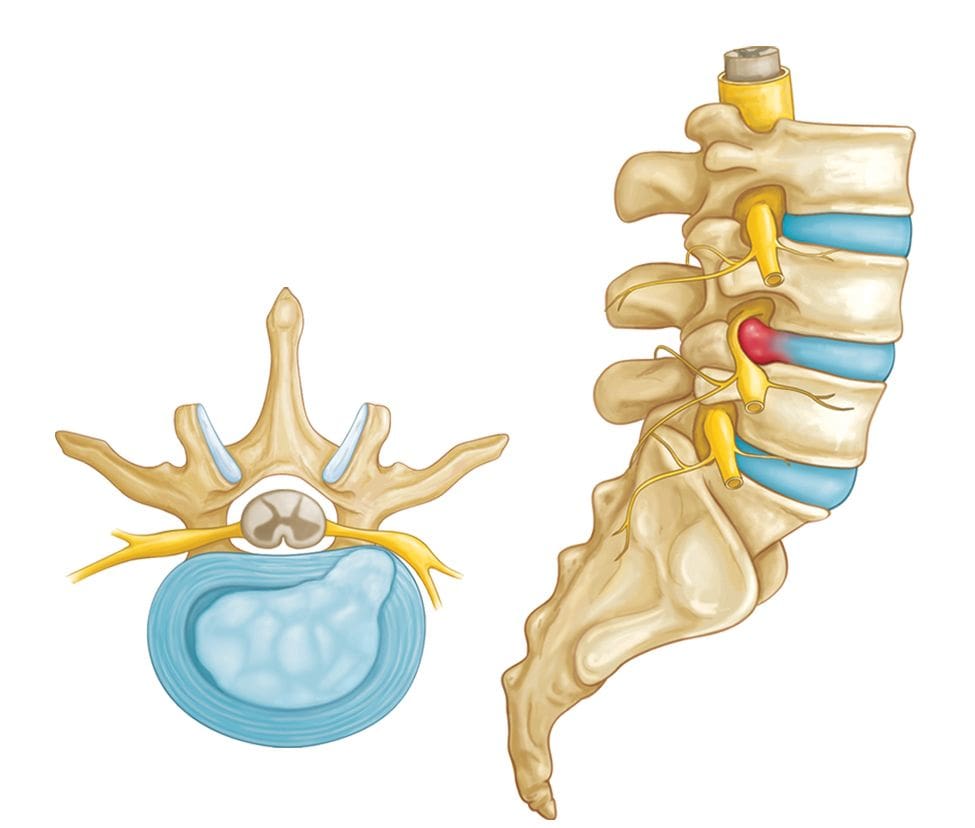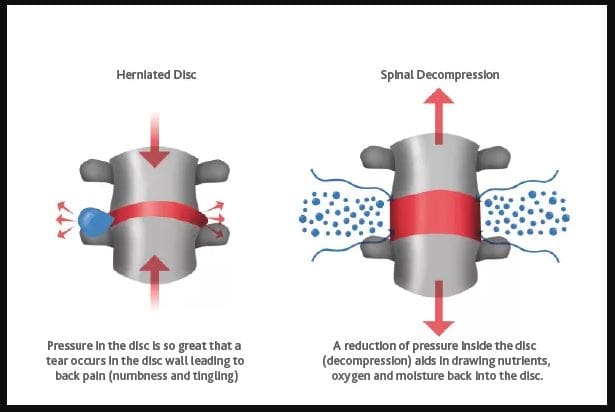How does non-surgical spinal decompression compare with traditional surgery to improve sensory abnornalities for individuals with herniated discs?
Introduction
The spinal column provides flexibility and stability to the body, consisting of vertebrae, spinal cord, nerve roots, and intervertebral discs. These components work with surrounding tissues, ligaments, and muscles, enabling pain-free mobility. However, activities or work that place excessive stress on the spine can cause damage, leading to misaligned discs and nerve root irritation. This can result in radiating pain in the lower extremities, which may be mistaken for other conditions such as low back pain, leg pain, or sciatica. This article will focus on the pain-like symptoms associated with herniated discs and how non-surgical spinal decompression can help people regain sensory function. We work with certified medical providers who use our patients’ valuable information to treat individuals suffering from herniated discs in their lumbar spine and inform them about non-surgical treatments to regain sensory function in their lower extremities. We encourage patients to ask essential questions and seek education from our associated medical providers about their condition. Dr. Jimenez, D.C., provides this information as an educational service. Disclaimer
The Symptoms Associated With Herniated Discs

Are you experiencing numbness or tingling down your leg that affects your walking? Does twisting or turning make your lower back uncomfortable? Or are you suffering from low back pain caused by sciatic nerve pain, making it difficult to work or do activities? Many people don’t realize they have herniated discs until repetitive movements cause wear and tear on the spine or constant compression causes the disc to crack, allowing the inner layer to protrude and press on the spinal nerve roots. Research studies reveal that herniated discs can result from various changes that cause pain-like symptoms, including limited trunk flexion, sensory abnormalities in the lower extremities, low back pain, radicular pain, sciatica, and intense distress when sitting. Herniated discs are common, and the inflammatory response from surrounding nerve roots can cause immense pain. As additional research shows, autoimmune responses released by the nucleus pulposus play a crucial role in the pathophysiology of sciatic pain and lumbar radiculopathy.
The Causes Of Herniated Disc-Video
Herniated discs can cause discomfort and pain depending on their severity and location. Several factors contribute to their development, including improper lifting of heavy objects, age, weight, and physical inactivity. Repetitive motions, constant stress, and autoimmune conditions also play a role. Disc herniation impacts the spinal structure and can cause sensory abnormalities in the lower extremities, muscular pain in the arms, back, foot, or leg, and affect the quality of life. However, non-surgical treatments are available to reduce disc herniation and restore the spine’s mobility, flexibility, and stability.
Treatments To Restore Sensory Function
If home remedies such as rest, hot and cold packs, and over-the-counter medications do not work, non-surgical treatments can effectively reduce the effects of disc herniation. These treatments are also safe, gentle, and cost-effective for many people who want relief without the financial burden. Chiropractic care, muscle energy techniques (MET), and spinal decompression are examples of non-surgical treatments that can help target the source of pain, reactivate the body’s natural healing process, and realign the body from herniated discs and spinal subluxation. These treatments can restore sensory function affected by herniated discs by addressing these issues.
Spinal Decompression

When dealing with herniated discs, many people turn to spinal decompression to alleviate pain and find relief in their spine. Studies have shown that spinal decompression involves using gentle traction to create negative pressure within the affected herniated disc. This can increase hydration and reduce pressure on the nerve root, easing the pain signals that affect the lower extremities. In “The Ultimate Spinal Decompression,” Dr. Eric Kaplan, D.C., FIAMA, and Dr. Perry Bard, D.C., explained that the duration of treatment for spinal decompression for herniated discs can vary depending on the severity. Mild herniation may require longer treatment, while patients with multiple herniations in different spinal locations may need additional sessions. However, the treatment should effectively reduce sensory abnormalities and relieve pain for the individual.
References
Kaplan, E., & Bard, P. (2023). The Ultimate Spinal Decompression. JETLAUNCH.
Disclaimer
Post Disclaimer *
Professional Scope of Practice *
The information herein on "Herniated Disc Protocols Implemented For Spinal Decompression" is not intended to replace a one-on-one relationship with a qualified health care professional or licensed physician and is not medical advice. We encourage you to make healthcare decisions based on your research and partnership with a qualified healthcare professional.
Blog Information & Scope Discussions
Welcome to El Paso's Premier Wellness and Injury Care Clinic & wellness blog, where Dr. Alex Jimenez, DC, FNP-C, a board-certified Family Practice Nurse Practitioner (FNP-C) and Chiropractor (DC), presents insights on how our team is dedicated to holistic healing and personalized care. Our practice aligns with evidence-based treatment protocols inspired by integrative medicine principles, similar to those found on dralexjimenez.com, focusing on restoring health naturally for patients of all ages.
Our areas of chiropractic practice include Wellness & Nutrition, Chronic Pain, Personal Injury, Auto Accident Care, Work Injuries, Back Injury, Low Back Pain, Neck Pain, Migraine Headaches, Sports Injuries, Severe Sciatica, Scoliosis, Complex Herniated Discs, Fibromyalgia, Chronic Pain, Complex Injuries, Stress Management, Functional Medicine Treatments, and in-scope care protocols.
Our information scope is limited to chiropractic, musculoskeletal, physical medicine, wellness, contributing etiological viscerosomatic disturbances within clinical presentations, associated somato-visceral reflex clinical dynamics, subluxation complexes, sensitive health issues, and functional medicine articles, topics, and discussions.
We provide and present clinical collaboration with specialists from various disciplines. Each specialist is governed by their professional scope of practice and their jurisdiction of licensure. We use functional health & wellness protocols to treat and support care for the injuries or disorders of the musculoskeletal system.
Our videos, posts, topics, subjects, and insights cover clinical matters and issues that relate to and directly or indirectly support our clinical scope of practice.*
Our office has made a reasonable effort to provide supportive citations and has identified relevant research studies that support our posts. We provide copies of supporting research studies available to regulatory boards and the public upon request.
We understand that we cover matters that require an additional explanation of how they may assist in a particular care plan or treatment protocol; therefore, to discuss the subject matter above further, please feel free to ask Dr. Alex Jimenez, DC, APRN, FNP-BC, or contact us at 915-850-0900.
We are here to help you and your family.
Blessings
Dr. Alex Jimenez DC, MSACP, APRN, FNP-BC*, CCST, IFMCP, CFMP, ATN
email: coach@elpasofunctionalmedicine.com
Licensed as a Doctor of Chiropractic (DC) in Texas & New Mexico*
Texas DC License # TX5807
New Mexico DC License # NM-DC2182
Licensed as a Registered Nurse (RN*) in Texas & Multistate
Texas RN License # 1191402
ANCC FNP-BC: Board Certified Nurse Practitioner*
Compact Status: Multi-State License: Authorized to Practice in 40 States*
Graduate with Honors: ICHS: MSN-FNP (Family Nurse Practitioner Program)
Degree Granted. Master's in Family Practice MSN Diploma (Cum Laude)
Dr. Alex Jimenez, DC, APRN, FNP-BC*, CFMP, IFMCP, ATN, CCST
My Digital Business Card



